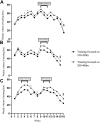Periodization of altitude training: A collective case study of high-level swimmers
- PMID: 36891142
- PMCID: PMC9986624
- DOI: 10.3389/fphys.2023.1140077
Periodization of altitude training: A collective case study of high-level swimmers
Abstract
The objective was to quantify parallel changes in performance and physiological measures in relation to periodization of sequential altitude training over a season in elite swimmers. The altitude training of four female and two male international swimmers in selected seasons was examined using a collective case study approach. All swimmers were a medalist in World (WC) and/or European Championships (EC) 2013, 2014, 2016 and 2018 in short or long course competition. A traditional periodization model was employed using three macrocycles with 3-4 altitude camps (duration 21-24 days each) scheduled over the season, following a polarized training intensity distribution (TID) with a volume ranged between 729 km and 862 km. The timing of return from altitude prior to competition was between 20-32 days, with 28 days the most common period. Competition performance was assessed with major (international) and minor (regional or national) competitions. Hemoglobin concentration, hematocrit, anthropometric characteristics, were measured before and after each camp. Competition performance following the altitude training camps improved by 0.6% ± 0.8% (personal best time; mean ± SD) (95% confidence limits (CL) 0.1%-1.1%), 1.6% ± 0.7% (95% CL 1.2% to 2.0%) (season best time) and 1.6% ± 0.5% (95% CL 1.3%-1.9%) (previous season time). Hemoglobin concentration increased 4.9% from pre-to post-altitude training camps, while hematocrit increased by 4.5%. The sum of six skinfolds reduced by 14.4% (95% CL 18.8%-9.9%) and 4.2% (95% CL 2.4%-9.2%) for the two males (EC), and by 15.8% (95% CL 19.5%-12.0%) for two females (WC). Three to four altitude training camps in a competitive season, around 21-24 days of duration, scheduling the last return between 20-32 days before the main competition, integrated in a traditional periodized sequence, can induce worthwhile improvements in international swimming performance, hematological parameters, and anthropometric characteristics.
Keywords: altitude; elite; integrated periodization; season; swimming.
Copyright © 2023 González-Ravé, Castillo, González-Mohino and Pyne.
Conflict of interest statement
The authors declare that the research was conducted in the absence of any commercial or financial relationships that could be construed as a potential conflict of interest. The handling editor RZ declared a past co-authorship with the author DBP.
Figures


References
-
- Fernández-Lázaro D., Mielgo-Ayuso J., Adams D. P., González-Bernal J. J., Fernández Araque A., Cano García A., et al. (2020). Electromyography: A simple and accessible tool to assess physical performance and Health during hypoxia training. A systematic review. Sustainability 12 (21), 9137. 10.3390/su12219137 - DOI
LinkOut - more resources
Full Text Sources

